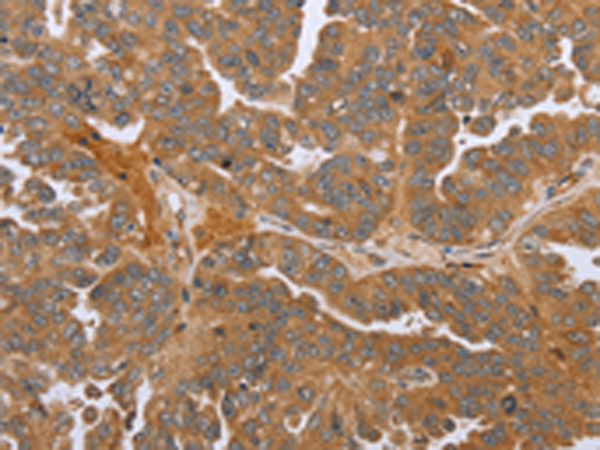


| WB | 1/1000 | Human,Mouse,Rat |
| IF | 咨询技术 | Human,Mouse,Rat |
| IHC | 1/100-1/500 | Human,Mouse,Rat |
| ICC | 技术咨询 | Human,Mouse,Rat |
| FCM | 1/10-1/50 | Human,Mouse,Rat |
| Elisa | 咨询技术 | Human,Mouse,Rat |
| Aliases | NMT |
| WB Predicted band size | 57 kDa |
| Host/Isotype | Rabbit IgG |
| Antibody Type | Primary antibody |
| Storage | Store at 4°C short term. Aliquot and store at -20°C long term. Avoid freeze/thaw cycles. |
| Species Reactivity | Human, Mouse, Rat |
| Immunogen | Synthetic peptide of human NMT1 |
| Formulation | Purified antibody in PBS with 0.05% sodium azide and 50% glycerol. |
+ +
以下是关于 SOD3 (N-term) 抗体的3篇参考文献及其摘要概括:
---
1. **文献名称**: "Extracellular Superoxide Dismutase (SOD3) and Its Role in Cardiovascular and Inflammatory Diseases"
**作者**: Carlsson LM, et al.
**摘要**: 该研究利用针对 SOD3 N 端的抗体,通过免疫印迹和免疫组化技术,揭示了 SOD3 在血管内皮细胞中的特异性定位及其在动脉粥样硬化中的保护作用,表明其通过清除细胞外超氧化物减轻氧化应激。
---
2. **文献名称**: "Characterization of a Polyclonal Antibody Against the N-Terminal Domain of Human Extracellular Superoxide Dismutase"
**作者**: Ookawara T, et al.
**摘要**: 研究团队开发并验证了一种针对 SOD3 N 端结构域的多克隆抗体,通过 ELISA 和免疫沉淀实验证明其高特异性,并用于检测人血浆及组织中 SOD3 的表达水平,为氧化应激相关疾病的诊断提供工具。
---
3. **文献名称**: "SOD3 Deficiency Induces Oxidative Stress and Accelerates Lung Inflammation in Mice"
**作者**: Adachi T, et al.
**摘要**: 通过使用 SOD3 N 端抗体进行免疫荧光染色和 Western blot,研究发现 SOD3 缺失小鼠肺部超氧化物积累增加,导致炎症加剧,提示 SOD3 在维持肺组织氧化平衡中的关键作用。
---
4. **文献名称**: "Role of the N-terminal Domain in Extracellular SOD3 Secretion and Function"
**作者**: Fattman CL, et al.
**摘要**: 利用针对 SOD3 N 端的抗体,研究揭示该结构域对 SOD3 的分泌和细胞外基质结合至关重要,突变分析表明 N 端缺失会显著降低其抗氧化能力,影响组织修复功能。
---
以上文献均涉及 SOD3 N 端抗体的应用,涵盖抗体开发、功能验证及在疾病机制研究中的具体作用。
**Background of SOD3 (N-term) Antibody**
The SOD3 (N-term) antibody is a specific immunological tool designed to target the N-terminal region of superoxide dismutase 3 (SOD3), also known as extracellular superoxide dismutase (EC-SOD). SOD3 is a member of the SOD enzyme family, which plays a critical role in antioxidant defense by catalyzing the dismutation of superoxide radicals into oxygen and hydrogen peroxide. Unlike the intracellular SOD1 and mitochondrial SOD2. SOD3 is secreted into the extracellular space, where it regulates oxidative stress in tissues and protects against inflammation, fibrosis, and vascular dysfunction.
The N-terminal domain of SOD3 is essential for its heparin-binding properties, enabling interaction with extracellular matrix components and cell surfaces. This region also influences the enzyme’s distribution and stability in tissues. Antibodies targeting the N-terminus of SOD3 are widely used in research to study its expression, localization, and function in physiological and pathological contexts, such as cardiovascular diseases, lung disorders, and neurodegenerative conditions.
SOD3 (N-term) antibodies are validated for applications including Western blotting, immunohistochemistry, and ELISA. Their specificity ensures minimal cross-reactivity with other SOD isoforms, making them valuable for distinguishing SOD3 from SOD1 or SOD2 in complex biological samples. Research utilizing these antibodies has advanced understanding of SOD3’s role in oxidative stress-related mechanisms and its potential as a therapeutic target or biomarker in disease.
×